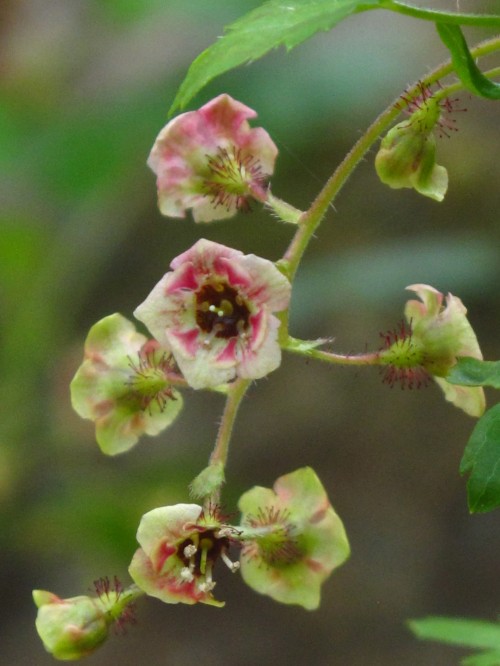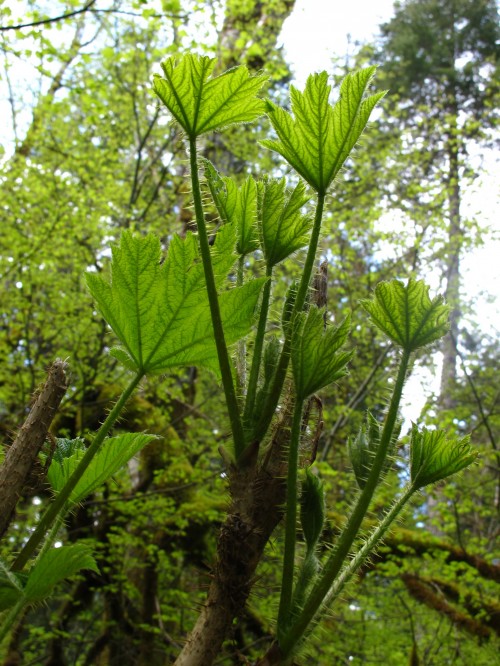Hey Bud

You know when you’re waiting and waiting for your meal to be served at a restaurant so you finally get up to go to the restroom, knowing your hot plate of deliciousness will likely have been brought to the table when you come back three minutes later?
I recently pulled that trick, only with my ecosystem.
Having persevered through a winter of twigs and more twigs, the promise enclosed in leaf and flower buds has been an exciting tease for the past month or so, little green gifts wrapped up tight, tender morsels for herbivorous deer and my appreciative eyes alike. But, save for Ribes, most were taking forever to crack, much less unfurl wantonly in their photosynthetic glory. So I left for ten days of spring break at the end of April, confident that the forest from which I drove away would look nothing like the lush kingdom to which I’d return.
It worked! At this point, I can’t even hope to keep up with the explosive profusion of photosynthetic beauty, and this is just fine. Here’s a sampling of new growth in full force all over the Environmental Learning Center campus:
 Vine maple (Acer circinatum) buds. Note the bright, licorice-red branches. These will turn green over time, an adaptation allowing the understory tree species to photosynthesize to its maximum potential even in low-light conditions or in the winter after it’s lost its leaves. Young green branches are flexible, and are used in making items such as snowshoe frames and drum hoops.
Vine maple (Acer circinatum) buds. Note the bright, licorice-red branches. These will turn green over time, an adaptation allowing the understory tree species to photosynthesize to its maximum potential even in low-light conditions or in the winter after it’s lost its leaves. Young green branches are flexible, and are used in making items such as snowshoe frames and drum hoops.
 Still crumpled like damp, newly-born birds’ wings, fresh vine maple leaves frame dangling flower buds, all covered in fine, shimmering hairs.
Still crumpled like damp, newly-born birds’ wings, fresh vine maple leaves frame dangling flower buds, all covered in fine, shimmering hairs.
 Vine maple leaves, seven-to-nine-pointed peridot stars catching sunlight in the mid-canopy. The half-inch wide flowers will, if successfully fertilized, develop into winged fruits called samaras, commonly know as “helicopter seeds.”
Vine maple leaves, seven-to-nine-pointed peridot stars catching sunlight in the mid-canopy. The half-inch wide flowers will, if successfully fertilized, develop into winged fruits called samaras, commonly know as “helicopter seeds.”
 There are a few black swamp gooseberry (Ribes lacustre) scattered around the wetter parts of campus. These small shrubs were propagated by the National Park Service from seeds gathered just yards away near Deer Creek and were planted as part of a successful restoration effort after the Environmental Learning Center was built in 2005. The detailed flowers are only about one-quarter inch big, and you can see the bulge at the base of the petals where the hairy fruit, purportedly very juicy and tart, will eventually form.
There are a few black swamp gooseberry (Ribes lacustre) scattered around the wetter parts of campus. These small shrubs were propagated by the National Park Service from seeds gathered just yards away near Deer Creek and were planted as part of a successful restoration effort after the Environmental Learning Center was built in 2005. The detailed flowers are only about one-quarter inch big, and you can see the bulge at the base of the petals where the hairy fruit, purportedly very juicy and tart, will eventually form.
 Oregon grape (Mahonia aquifolium): This year’s recently emerged, pliable, scarlet-tinged new growth on the left contrasts with the tough, leathery leaves from last year on the right.
Oregon grape (Mahonia aquifolium): This year’s recently emerged, pliable, scarlet-tinged new growth on the left contrasts with the tough, leathery leaves from last year on the right.
 Red alder (Alnus rubra) buds form on the young saplings that are growing at the edge of almost every road or significant path at the Environmental Learning Center. Why the profusion? Alder trees love disturbed sites, and are some of the first “pioneer” species that come into an ecosystem after land has been cleared. Since the buildings are less than a year old, this species is thriving.
Red alder (Alnus rubra) buds form on the young saplings that are growing at the edge of almost every road or significant path at the Environmental Learning Center. Why the profusion? Alder trees love disturbed sites, and are some of the first “pioneer” species that come into an ecosystem after land has been cleared. Since the buildings are less than a year old, this species is thriving.
 Beetle-mania! Iridescent cyan insects congregate on an alder leaf, munching away on the new growth. Several of the leaves in this grove between the parking lot and the office were the site of such six-legged shenanigans.
Beetle-mania! Iridescent cyan insects congregate on an alder leaf, munching away on the new growth. Several of the leaves in this grove between the parking lot and the office were the site of such six-legged shenanigans.
 Recognize these spines? New growth of devil’s club (Oplopanax horridus), an exceptionally important plant to indigenous tribes along the Pacific Northwest coast. This species can be used for everything from perfume and deodorant (pulverized bark) to treating lice (berries) and rheumatism (roots and stems). A Mountain School student from the Swinomish tribe in La Conner said his mom makes paint from this versatile plant.
Recognize these spines? New growth of devil’s club (Oplopanax horridus), an exceptionally important plant to indigenous tribes along the Pacific Northwest coast. This species can be used for everything from perfume and deodorant (pulverized bark) to treating lice (berries) and rheumatism (roots and stems). A Mountain School student from the Swinomish tribe in La Conner said his mom makes paint from this versatile plant.
 Phyto-palms stretched upward toward the light, the devil’s club buds have burst into leaves that will eventually grow up to over a foot across. Mention of another local use for this plant was gleaned from John Suiter’s book, Poets on the Peaks (Counterpoint, 2002): To flog accused communists in the Skagit Valley during the Red Scare of the 1930s.
Phyto-palms stretched upward toward the light, the devil’s club buds have burst into leaves that will eventually grow up to over a foot across. Mention of another local use for this plant was gleaned from John Suiter’s book, Poets on the Peaks (Counterpoint, 2002): To flog accused communists in the Skagit Valley during the Red Scare of the 1930s.
 The tough, oval leaves of the ubiquitous salal (Gautheria shallon) frame the soft, blushy red buds that will later develop into smaller stems.
The tough, oval leaves of the ubiquitous salal (Gautheria shallon) frame the soft, blushy red buds that will later develop into smaller stems.
All photos by author.
Katherine Renz is a graduate student in North Cascades Institute and Western Washington University’s M.Ed. program. She readily admits she has a problem, an addiction to snapping photos of all things botanical, a pathological attraction to leafy supermodels.



This was wonderful — the photos and the writing. A keen eye, interesting facts and keen wit. Now I want to camp out next to devils club (and everything else!) and watch them metamorphose through spring.
Delightful reading and viewing.
Thank you, Jack and Floy! Jack, I just picked up your book, The North Cascades Highway: A Guide to the American Alps. Finally! I’m starting to ride my bike again and I need a better sense of the natural and cultural history of what I’m seeing. So thank you. Say hi to the Everett kids for me!